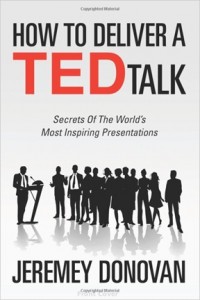 I will assume that most of you are familiar with TED talks. If not, they are basically a forum for ordinary people to share their extra-ordinary stories on a public stage.
I will assume that most of you are familiar with TED talks. If not, they are basically a forum for ordinary people to share their extra-ordinary stories on a public stage.
I am currently reading “How To Deliver A TED Talk” by Jeremy Donovan. Now before you quit reading just because you have no intention of ever giving a TED talk let me ask you a question. Have you ever wanted to share an idea with someone and actually have them buy into it? Keep reading.
Donovan, a long time spectator as well as participant in TED talks, has done an amazing job in laying out what it takes to deliver a TED talk. This is part 1 of a 2 post series on not just how to deliver a TED talk, but how to tell a story in a way that will move and influence others.
Part 1 will center on the content, story and structure. Part 2 will focus on delivery and design.
HOW TO SELECT YOUR TOPIC
When selecting your topic, Donovan makes the point that we need to make a connection with the audience at some level. He suggests using something within what he identifies as the “four deep rooted needs.”
- The need for love and belonging
- Desire and self-interest
- Accelerating personal development
- Hope and Change
HOW TO CRAFT YOUR CATCHPHRASE
Donovan points out that captivating the audience needs to be done early and with a short, but powerful catchphrase. He references Simon Sinek, who has one of the highest viewed TED talks, who started with the “why” by using “People don’t buy what you do, they buy why you do it.”
HOW TO BE INTRODUCED
Donovan makes it clear that people don’t want to know your resume, they want to know what they will take away from investing their time in listening to you. At least in the TED environement, the three tenets to focus on are:
- What is in it for them
- Maximize topical relevance
- Minimize biographical information
HOW TO OPEN YOUR TALK
The first ten or twenty seconds of your speech will determine the engagement of the audience. Donovan suggest his three best options for opening your speech:
- Tell a personal story
- Make a shocking statement
- Ask a powerful question
HOW TO BUILD YOUR SPEECH BODY AND TRANSITIONS
Donovan suggest using one of three frameworks to build the body of your speech. No one is better than the others but using one of them is critical.
- Situation-complication-resolution
- chronological narrative
- idea-concepts description
HOW TO CONCLUDE YOUR TALK
Simply, your closing should be to reinforce the benefit to your audience. Remember when we talked about the “why” of your talk? Your closing should be a clear and powerful description of your why and some type of call to action. “The consequences of failure are …”, “By doing this, you will …” and so on.
As a proponent of the coaching process and the power of open ended questions, I prefer to use a powerful question in closing my talks. Something the listener will ponder all the way home.
HOW TO TELL STORIES
The greatest power of telling a story is when it is told in such a way that the listener is able to put themselves in the same situation. Finding common ground with your listener is the ultimate way to connect with them. They have to care about what you are saying for it to influence a change.
Be passionate about your topic and tap the emotion of your listener and you will leave a lasting impression that will make a difference.
So a thought as we wrap up part 1. It doesn’t matter if you are on a stage in front of thousands or simply sitting in the car with your spouse, when you tell a story do it like you believe in what you are saying. Do it like you are telling the last person on earth.
Passion and emotion are contagious and if you want to make a difference or influence an outcome, start with why you want to do it.
***********************************************************************
Don’t miss a single post from Building What Matters by subscribing at the top left of this page.
Help support us by clicking here and Liking our facebook page
Barry Smith 6/5/13 photo courtesy of amazon.com © Building What Matters 2013


Thanks for this capsulized post of Donovan’s book. I’m interested enough to order it right now.
Right on Nanette. You won’t be disappointed!
Hi Barry,
Jeremey’s book is fantastic. You are right that it is useful for anyone that delivers presentations. His tips are practical and tangible and the book has absolutely no fluff.
Thank you for sharing your thoughts.
Best,
Nana
Thanks Nana. I totally agree with your assessment of “practical and tangible” tips. Very little fluff in this book. It’s all great content.
This was a great resource. Thank You